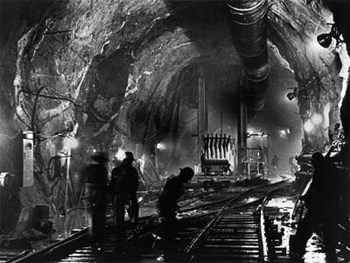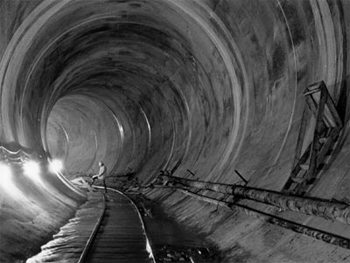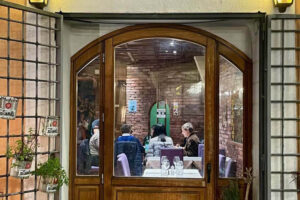A Visit to the Land of the Sandhogs, NYC Underground City Below Manhattan
By David Grann

No one knows how many sandhogs are, at any given moment, working beneath Manhattan in the New York Underground City below the streets of New York City.
But one winter morning half a dozen men could be spotted gathering around a hole on the northwest corner of Tenth Avenue and Thirtieth Street.
The hole, surrounded by a tall aluminum fence, was thirty feet wide and reinforced with concrete.
A priest had visited months before, to offer a brief prayer: “May God be with all ye who enter here, that the earth shall return ye safely.”
Now, as the sun rose, the men stepped from the snow-covered ground into a green metal cage, which was suspended over the chasm by an enormous winch.
They wore yellow slickers and rubber boots with steel tips; they carried, among other things, flashlights, scissors, cigarettes, cough drops, knives, extra socks, and several twenty-pound crates marked “explosives.”
A worker who was to remain above ground pulled a lever, and the cage began to descend. As it accumulated speed, and the light from the surface grew thinner, James Ryan, one of the older men in the crew, peered over the edge into the void. He had a long, hard face flecked with scars. “We got nine cases of dynamite,” he said. “That should be plenty.”
600 Feet Under Manhattan in NYC’s Underground City
His voice reverberated in the shaft as the men went down thirty, forty, fifty feet, then another fifty, then a hundred more. “Two hundred,” one of them called out. By three hundred feet, they could no longer see anything above or below.
Surrounded by darkness, and pressed closely together, the men exchanged sight for sound—the ping of dripping water, the echo of voices, the cable groaning overhead.
At five hundred feet, the air became warmer and denser; one of the men put on a mask to keep out the dust that floated through the shaft. “All right,” Ryan told me. “We’re almost there.”
A thin beam from a flashlight suddenly rose up from the bottom of the shaft, catching the men’s faces. They were all part of the fraternity of sandhogs, a rare breed of tunnel digger whose name comes from the workers who excavated the soft earth under the Brooklyn Bridge in the eighteen-seventies.
The men in the cage with me were mostly middle-aged, with barrel chests and knotted fingers; dust had already begun to streak the skin around their eyes. A bell sounded, and the cage came to a halt, bouncing up and down on the cable. “This is it,” Ryan said. “Brace yourself.” He unsealed the cage door.
We were nearly six hundred feet underground.
Until that moment, I had only heard tales of New York City’s invisible empire, an elaborate maze of tunnels that goes as deep as the Chrysler Building is high.
Under construction in one form or another for more than a century, the system of waterways and pipelines spans thousands of miles and comprises nineteen reservoirs and three lakes. Two main tunnels provide New York City with most of the 1.3 billion gallons of water it consumes each day, ninety percent of which is pumped in from reservoirs upstate by the sheer force of gravity.
Descending through aqueducts from as high as fourteen hundred feet above sea level, the water gathers speed, racing down to a thousand feet below sea level when it reaches the pipes beneath the city.
It is a third water tunnel, however, that is the most critical. Designed to meet expanding demand and to serve as a backup system in case something ever happens to City Tunnel No. 1 or City Tunnel No. 2, City Tunnel No. 3 has been under development since 1969 and was initially billed as “the greatest nondefense construction project in the history of Western Civilization.” Already, twenty- four people have died building it—roughly a man a mile—and it is not expected to be completed until 2020.
As an engineering feat, the water-tunnel system rivals the Brooklyn Bridge and the Panama Canal. Yet it has the odd distinction that almost no one will ever see it, save for the sandhogs who are building it. Over the years, the men have constructed an entire city under the city, a subterranean world as cluttered as the Manhattan skyline: it includes four hundred and thirty- eight miles of subway lines, six thousand miles of sewers, and thousands of miles of gas mains.
“If it’s deeper than a grave,” sandhogs often say, “then we built it.” The water tunnels have become the sandhogs’ greatest and most elusive achievement, an often deadly effort that has consumed generations. “I’ll take you down there if you want,” Jimmy Ryan had said when I asked him to show me the tunnel’s newest section. “But, trust me, it ain’t like Macy’s down there.”
He Prefers Gestures

A large, reticent man of fifty who prefers gestures—an upturned eyebrow or a curled lip—to words, he has spent nearly as many hours underneath the earth as above it. “I started working on the third water tunnel when I was a kid,” he told me. “I’m still working on it, and I’ll probably be buried in it.”
Ryan, who was elected president of the sandhogs’ union, Local 147, in 1999, has trouble lifting his shoulders; his red hair has turned silver, and his broad chest is compressed as if it were about to collapse.
After Ryan opened the cage, I stepped out with him and the other men into the bottom of the shaft. Water seeped down the sides of the opening and dripped on us. There was a pool at our feet, and as we moved forward the icy water spilled over the tops of our boots. I began to sink in the muck, and Ryan gave me his hand to pull me out.
“Don’t stand under the shaft,” he said. “If somethin’ falls from the top, it’ll go right through you.” I looked up and could barely see the opening. Once, in Queens, a sixteen-ton winch fell down the shaft, crushing one worker and injuring seven others; another time, a man died after being impaled by a broken icicle.
As I followed Ryan into the tunnel’s main artery, it was hard to orient myself. There were only a few scattered electric bulbs, suspended from wires clamped to rocks and shrouded in mist, and I blinked, trying to adjust to the watery light. Several of the men turned on flashlights; through the shadows, I could see a hospital stretcher and emergency medical supplies propped against a wall. At last, the tunnel came into focus: a cramped, crumbling cavern that extended a hundred yards or so in either direction.
Manhattan Bridge to Central Park
This stage of Tunnel No. 3 will eventually run nine miles, reaching down to the Manhattan Bridge and looping up to Central Park; its walls will be honed into a smooth cylinder, ten feet in diameter, and lined with concrete. But at this early stage swords of black schist—formed more than four hundred million years ago—hung from the ceiling, which was buttressed with steel bolts to prevent collapse.
Ventilation pipes ran along the sides of the tunnel, circulating the choked air, which, unlike the freezing air at the surface, was nearly seventy degrees, a humid mist of dust and fumes.
The men split into two groups and went to opposite ends of the tunnel, where they began painting detailed patterns on the rock face. Moving out from the center of the rock, they carefully dabbed white dots about three feet apart, forming an elaborate grid. Then the sandhogs mounted hydraulic drills and bored a ten-foot-deep hole into each mark, their arms, and legs rattling up and down, the lamps on their hard hats shaking.
As the men prepared the rock face, listening to each echo for any sign of danger, they spoke in a private language: a jackhammer was known as a “jackleg”; a bucket, a “battleship”; the Nerf-like sponge used to clean a pipe was called a “rabbit.”
Sometimes, because of the noise, the men would simply draw images in the air, like mimes. After a while, they took out blowpipes, which blasted air and water into the holes, washing away the dirt. “Everything has to be done just right,” Ryan told me.
With his knife, he opened one of the boxes of explosives. Inside were dozens of red sticks of dynamite. The men packed the sticks into the holes as if loading muskets. Each piece of dynamite was wired to the next, and soon dozens of cords crisscrossed the rock face.
Then the men turned off the lights, one by one, until the tunnel was completely dark, except for a single flashlight that guided us back to the metal cage. “We need to be a thousand feet away,” Ryan said, as we slowly rose to the surface. “It’s not like the old days when they’d blow the son of a bitch in your ear.”
When we reached the street, the sun was fully in the sky, and Ryan squinted uncomfortably in the light. He leaned over a small detonator while the men cleared the intersection of pedestrians. A woman in a camel coat, who insisted that she was late for work, tried to force her way past.
“One minute,” Ryan said, cocking an eyebrow. Another sandhog put his hand on the T-shaped lever. “Now,” Ryan said. The sandhog slammed the lever with both hands, yelling, “Fire in the hole! Fire in the hole!”
There was a great roar, a percussive rumble that grew louder and louder. The sidewalk and fences began to tremble, along with the ground beneath our feet. The crane that was suspended above the hole rattled from side to side.
One bystander looked up at the sky, then down at the ground, not sure what was happening. “Is it a bomb?” another asked. A plume of dust rose out of the shaft. Then everything fell silent. The tunnel had advanced another nine feet. “All right, hogs!” the foreman yelled. And, before anyone noticed, Ryan and the other men vanished into the hole.
At the end of the day, the sandhogs congregated in the hog house, a small white shack with wooden benches, lockers, and a shower, inside the fenced area on Thirtieth Street. Yellow slickers, now black with mud, hung from hooks. A television set murmured in the corner, and several men stood around it in towels while another mopped the floor around their feet.
Ryan sat down at a table to talk with me. His elbow rested on his hard hat; a line of mud traced the side of his cheek. He had lost part of his hearing from the constant concussions, and he spoke louder than normal.
“No one wants to talk about it, but we’re flirting with disaster,” he said. The old tunnels, Ryan explained, were leaking “like a sieve”; some of the sections were built nearly a century ago and were in desperate need of repair.
But until Tunnel No. 3 is virtually complete there will be no way to fix them. In part, this is because getting inside Tunnel No. 1 or No. 2 would require the city to shut the water off, and without a backup supply, there would be serious water shortages. But it was more than that, and, as several sandhogs peered over his shoulder, Ryan started to draw a circle on the table with his muddy finger. “See this?” he asked me. “These are the valves that control the flow of water.”
“They’re hundreds of feet underground,” another sandhog said. The valves were designed, Ryan said, to open and close guillotine-like gates inside the cylindrical tunnels, stopping the flow of water. But they had become so brittle with age that they were no longer operable.
“They’re afraid if they try to shut the valves they won’t be able to turn ’em back on,” Ryan said.
He wiped some mud from his eyes. “Look,” he said. “If one of those tunnels goes, this city will be completely shut down. In some places, there won’t be water for anything. Hospitals. Drinking. Fires. It would make September 11th look like nothing.”
Ryan wasn’t the only one who spoke of the tunnel system’s frailties, even if the others did so in slightly less alarming terms. One day in the spring of 2003, I met Christopher Ward, the head of the city’s Department of Environmental Protection, which is responsible for designing and operating the tunnel system.
With a broad chest and a blunt, goateed chin, he looks more like a sandhog than like a politician and has a tendency to lean forward when he speaks as if about to leap to his feet. “People don’t want to acknowledge it, but the useful life of a tunnel does exist, and at some point, it does start to fail,” he said.
The metal valves, in particular, degrade until they can no longer withstand the pressure. Ward said that the original two tunnels were so dilapidated that it was too risky to try to shut off the water and repair them until City Tunnel No. 3 was operational. He added that there is still time before the aging tunnels collapse—“We’re not talking about today or tomorrow”—though it is impossible to predict how much.
Hemorrhaging Water Badly
Others are more pessimistic. One D.E.P. scientist told me, “Some of the aqueducts are already hemorrhaging water badly,” while a recent study by Riverkeeper, an environmental organization, concluded, “In some cases, this extraordinary infrastructure is literally crumbling.”
Upstate, in the industrial town of Newburgh, for example, water has begun to pour out of cracks in the underground aqueduct that feeds into the city tunnels—so much that the leaks have created a giant sinkhole.
Many experts worry that the old tunnel system could collapse all at once. “Engineers will tell you if it fails it will not fail incrementally,” said Ward. “It will fail catastrophically.” If City Tunnel No. 1, which is considered the most vulnerable, caved in, all of lower Manhattan and downtown Brooklyn, as well as parts of the Bronx, would lose its water supply. If the aqueducts gave out, the entire city would be cut off. “There would be no water,” Ward told me. “These fixes aren’t a day or two. You’re talking about two to three years.”
In the past, the city sometimes tried to assuage concerns about New York’s water system, but Mayor Michael Bloomberg noted at a 2003 press conference that the aging pipelines were “very vulnerable” and that “this city could be brought to its knees if one of the aqueducts collapsed.”
Anthony DelVescovo, the project manager who has been working on City Tunnel No. 3 for nearly fifteen years, echoed Bloomberg’s warning. “What no one knows is that we’re facing a potential apocalypse,” he told me. “
Excerpted from The Devil and Sherlock Holmes by David Grann Copyright © 2010 by David Grann. Excerpted by permission of Doubleday, a division of Random House, Inc. All rights reserved. No part of this excerpt may be reproduced or reprinted without permission in writing from the publisher.
 David Grann is a staff writer at The New Yorker magazine and the author of The Devil and Sherlock Holmes: Tales of Murder, Madness, and Obsession. His first book, The Lost City of Z: A Tale of Deadly Obsession in the Amazon, was a #1 New York Times bestseller and has been translated into more than twenty-five languages. It was chosen as one of the best books of 2009 by the New York Times, the Washington Post, and Entertainment Weekly, and was named one of the best travel books by Worldhum and the Los Angeles Times.
David Grann is a staff writer at The New Yorker magazine and the author of The Devil and Sherlock Holmes: Tales of Murder, Madness, and Obsession. His first book, The Lost City of Z: A Tale of Deadly Obsession in the Amazon, was a #1 New York Times bestseller and has been translated into more than twenty-five languages. It was chosen as one of the best books of 2009 by the New York Times, the Washington Post, and Entertainment Weekly, and was named one of the best travel books by Worldhum and the Los Angeles Times.
In the same spirit of curiosity and discovery, The Devil and Sherlock Holmes contain a dozen true stories that, to borrow a phrase from Holmes, are “infinitely stranger than anything which the mind of man could invent.” They take the reader on an adventure around the world, exploring everything from the mysterious death of the greatest Sherlock Holmes expert to the hunt for the giant squid.
- These 9 U.S. National Parks Require Reservations in 2024 - April 17, 2024
- Take a Hike in Olympic National Park - April 17, 2024
- The Wild Mississippi: 2340 Miles Across Ten States - April 8, 2024





